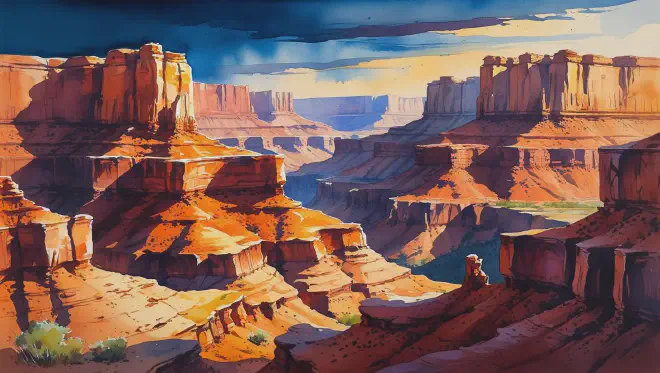Introduction: A Labyrinth of Red Earth
Canyonlands National Park, sprawling across southeastern Utah, is a magnificent canyon region carved by the Colorado and Green Rivers. The vast 337-square-mile preserve is divided into three distinct districts: Island in the Sky, The Needles, and The Maze, each revealing its own unique character.
Human footprints first marked this land over 10,000 years ago. The Ancestral Puebloans (formerly known as the Anasazi) and Fremont peoples left behind petroglyphs and dwelling sites that still quietly narrate the passage of time. Designated as a national park in 1964, this place preserves one of the purest forms of the American West’s primordial beauty.
The red-brown sandstone layers chronicle approximately 200 million years of Earth’s history, spanning from the Permian to the Cretaceous periods. The sculptural beauty carved by wind and water over eons transcends human imagination—it is nature’s art in its most sublime form.
The park stands as a testament to geological forces that shaped our planet, where ancient seabeds became towering mesas, and patient erosion created a maze of canyons that stretch beyond the horizon. Here, in this cathedral of stone, time moves differently, measured not in minutes or hours, but in millennia.

Day 1: Standing at the Canyon’s Gateway
After a five-hour drive south from Salt Lake City, I arrived at Canyonlands National Park Visitor Center around 10 AM, having passed through the town of Moab. As I collected my map at the reception desk, a ranger shared the day’s weather forecast. “We might see some clouds this afternoon, but conditions should be perfect for sunset viewing,” she said with a smile that kindled my anticipation.
My first destination was Mesa Arch Road in the Island in the Sky district. The paved road revealed an otherworldly landscape on both sides—layered red sandstone mesas stacked like ancient books, with the snow-capped La Sal Mountains visible in the distance. Stepping out of the car, I drew a deep breath of the dry air, catching the faint scent of sagebrush carried on the desert breeze.
The morning’s first stop was Grand View Point. The short two-mile trail from the parking area led to a vista that literally took my breath away. Six thousand feet below, the Colorado River meandered like a silver thread, while countless canyons formed an intricate maze stretching to the horizon. I settled onto a bench, letting the wind caress my face as I absorbed the immensity before me. Occasionally, the distant call of what might have been coyotes drifted across the silence.
Lunch was a simple affair at the picnic area in nearby Dead Horse Point State Park. My sandwich and apple were humble fare, but any meal tastes extraordinary when accompanied by such breathtaking scenery. At the neighboring table, a German family chatted cheerfully, reminding me that people from around the world are drawn to witness this beauty.
The afternoon found me back in Canyonlands, driving the Upheaval Dome Road. The White Rim Overlook Trail offered a relatively easy three-mile round-trip hike, allowing me to observe the fascinating geological layers along the way. Cedar trees (actually junipers) dotted the landscape, and spring wildflowers had sprouted from rock crevices following recent rains, adding delicate splashes of color to the red stone canvas.
After checking into my Moab hotel that evening, I explored the town center. Though Moab has only about 5,000 residents, it buzzes with outdoor enthusiasts. I saw mountain bikes strapped to car roofs, young people shouldering rock climbing gear, and families equipped for hiking adventures—all drawn by this land’s irresistible appeal.
Dinner at the locally renowned Broken Oar Pub featured their signature green chile burger, where local beef was perfectly complemented by fresh vegetables and a kick of green chile. I paired it with a pale ale from Moab Brewery, savoring the local flavors. A conversation with a local man at the next table offered insights into Canyonlands from a native’s perspective. “Even seeing it every day, the light makes it look completely different each time,” he said, and his words resonated deeply with me.
Back in my hotel room that night, reviewing the day’s photographs, I was struck by how the camera couldn’t capture the true vastness of what I’d witnessed. As I drifted off to sleep, I looked forward to exploring this land more deeply tomorrow.
Day 2: Following Ancient Footsteps
I rose at 5 AM to catch the sunrise at Mesa Arch. In the pre-dawn darkness, I followed the half-mile trail by flashlight, finding several photographers already positioned with their tripods. Thirty minutes before sunrise, the eastern sky began to glow orange, and Mesa Arch emerged as a silhouette against the brightening horizon. When the sun finally appeared, the arch blazed with an inner fire of brilliant red. The sacred beauty of that moment held us all in reverent silence, cameras clicking softly in the stillness.
Breakfast in Moab was a classic American combination of pancakes, bacon, and coffee at the Jailhouse Cafe, a charming establishment housed in a converted old jail. The unique décor matched the restaurant’s name, while local regulars chatted amicably at the counter, creating a warm, welcoming atmosphere that touched my heart.
Today’s main adventure lay in exploring The Needles district. After an hour’s drive from Moab, I gathered information at the visitor center before heading to the Chesler Park Trail. This challenging 11-mile round-trip hike would take me through a wonderland of rock formations that once lay beneath ancient seas.
The red and white striped spires that gave “The Needles” its name resembled a natural sculpture garden. The striking contrast between the Cedar Mesa sandstone and White Rim sandstone layers created a masterpiece of geological artistry. Along the trail, petroglyphs left by the Ancestral Puebloans remained vivid on the rock walls—handprints that serve as precious evidence of people who lived here over 800 years ago.
I ate lunch in the shade of a massive boulder, savoring my packed sandwich in the dry desert air while staying well-hydrated for the afternoon’s hiking. With fewer tourists during these midday hours, wildlife sightings were more frequent. I spotted ground squirrels, lizards, and occasionally caught glimpses of eagles soaring overhead.
The afternoon brought me to the Joint Trail, a route that winds through narrow cracks in the rock. These passages, some barely shoulder-width, were formed by ancient tectonic forces, and walking through them felt like traversing the very bones of the earth. Looking up from these crevices, the sky appeared as a thin blue ribbon, creating an almost surreal spatial experience.
On my return to Moab, I stopped at a newsstand to buy the local paper. Reading about the small-town life—high school basketball scores, city council recycling initiatives, announcements of local art exhibitions—warmed my heart with the sense of community that’s hard to find in urban areas.
Dinner at Pasta Jay’s surprised me with authentic Italian cuisine and wine, a perfect comfort after a day of hiking. The owner made rounds to chat with customers, exemplifying the personal touch that makes Moab special.
Back at the hotel, I massaged my tired feet while reflecting on the 11 miles I’d walked. Following the footsteps of ancient peoples had created an experience far deeper than mere sightseeing. Outside my window, the star-filled sky revealed the Milky Way with a clarity impossible to see in the city.
Day 3: Surrendering to Time’s Flow
My final morning brought a different quality of quiet as I awakened. After checking out, I had planned to briefly visit Arches National Park before heading home, but I felt drawn to return to Canyonlands one more time.
The morning found me back in the Island in the Sky district, this time walking the quieter Mahogany Flat area. With fewer tourists here, I could enjoy solitary contemplation. Sitting on the smooth rock surface, I listened to the wind carrying sounds from distant canyons. Time seemed to blur—whether I sat for thirty minutes or two hours, I couldn’t say, as I fell into a deep meditative state.
Here I met Sarah, a graduate student studying geology who had come alone for research. Her passionate explanation of rock formation processes illuminated the landscape with new understanding. “This place is a 200-million-year textbook of Earth’s history,” she said, her eyes bright with enthusiasm. Meeting someone with such expertise became one of the journey’s unexpected treasures.
For lunch, I wanted somewhere special and returned to Grand View Point. The light was completely different from my first visit, transforming the canyon’s expression entirely. As I ate my sandwich and fruit, I reflected on these three days. Though my body was tired, my spirit felt strangely calm and fulfilled.
The afternoon took me to the entrance of White Rim Road, a 100-mile 4WD route through the backcountry. Though I only walked near the entrance, seeing this road sparked a new dream of someday driving its entire length. A local guide I met along the way shared his wisdom: “Canyonlands offers new discoveries every visit. I hope you’ll come back in different seasons.”
In the evening, I took a final walk through Moab’s streets. I purchased a small ceramic piece made by a local artist, and the elderly shop owner shared stories about the area’s seasons—spring wildflowers, summer’s heat but spectacular sunsets, autumn’s changing leaves and crisp air, and winter’s snow-dusted canyons that look mystical. Each season sounded appealing, strengthening my desire to return.
Driving toward the airport, I tried to process the three days’ experiences. While the vast landscape had made me acutely aware of human smallness, tracing the footsteps of ancient peoples had also revealed the continuity of human experience across time. Canyonlands was more than a tourist destination—it was a place for self-reflection and deep contemplation of time’s passage.
From the airplane window, Utah’s landscape remained magnificent even from above. The countless canyons carved into the red earth resembled the planet’s circulatory system. Burning this image into my memory, I promised myself to return to this land someday.
Conclusion: What Felt Real Despite Being Imagined
My three-day journey through Canyonlands National Park, though imaginary, has etched itself deeply into my consciousness. The texture of red sandstone, the scent of dry air, the sound of wind, the star-filled sky, and the warmth of people I met—all remain vivid in my memory.
This journey revealed the universal nature of human humility when faced with natural grandeur, and the deep emotions that beautiful places awaken in us. Standing before ancient petroglyphs, I felt a profound connection to people across time and cultures who experienced similar wonder in this same place.
I also came to understand that travel is not merely about visiting places, but about engaging with local history, culture, and people in ways that prompt self-reflection. Within Canyonlands’ vast temporal landscape, I found release from daily worries and hurried living, gaining space to contemplate more essential truths.
Though this was an imaginary journey, the experience exists genuinely within me and will continue to influence my life. When I eventually visit this place in reality, I’m curious to discover how closely my imagined experience matches the actual one. I look forward to layering new discoveries and emotions onto these foundational memories.
Canyonlands National Park—a sacred place where Earth’s history and human experience intersect across time.

